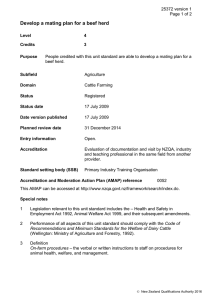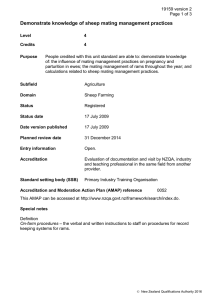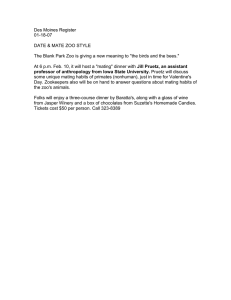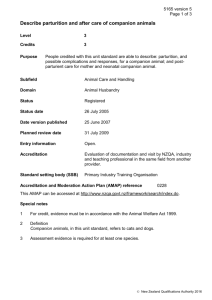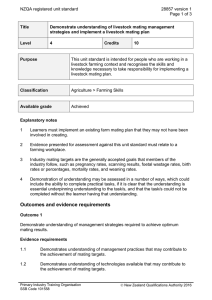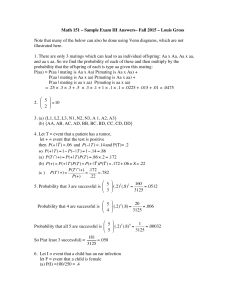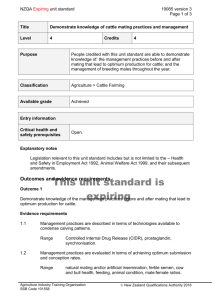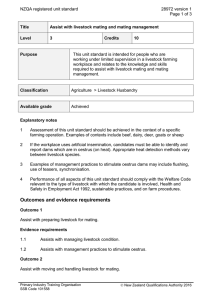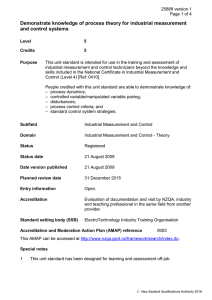Demonstrate knowledge of livestock mating management - goats
advertisement
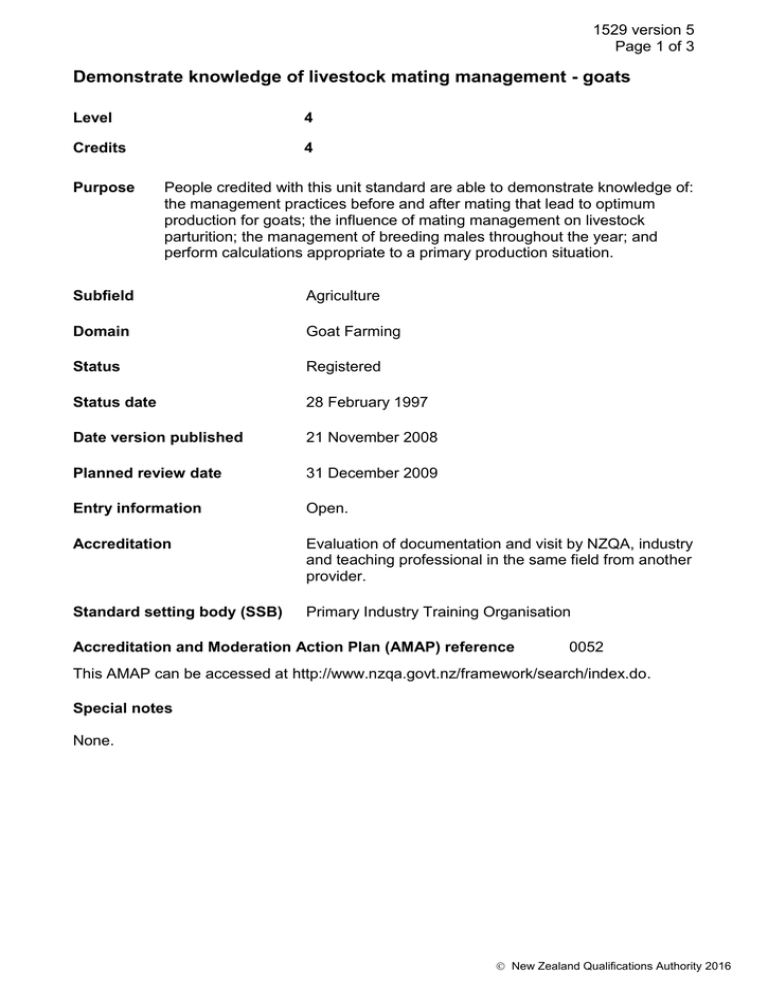
1529 version 5 Page 1 of 3 Demonstrate knowledge of livestock mating management - goats Level 4 Credits 4 Purpose People credited with this unit standard are able to demonstrate knowledge of: the management practices before and after mating that lead to optimum production for goats; the influence of mating management on livestock parturition; the management of breeding males throughout the year; and perform calculations appropriate to a primary production situation. Subfield Agriculture Domain Goat Farming Status Registered Status date 28 February 1997 Date version published 21 November 2008 Planned review date 31 December 2009 Entry information Open. Accreditation Evaluation of documentation and visit by NZQA, industry and teaching professional in the same field from another provider. Standard setting body (SSB) Primary Industry Training Organisation Accreditation and Moderation Action Plan (AMAP) reference 0052 This AMAP can be accessed at http://www.nzqa.govt.nz/framework/search/index.do. Special notes None. New Zealand Qualifications Authority 2016 1529 version 5 Page 2 of 3 Elements and performance criteria Element 1 Demonstrate knowledge of the management practices before and after mating that lead to optimum production for goats. Performance criteria 1.1 Management practices which correspond to factors determining high submission rates are explained in relation to feeding regime, animal condition, libido, heat and cycling identification, synchronisation, animal health, recordkeeping, and post-part problems. 1.2 Management practices which correspond to factors determining optimum conception rates are explained in relation to natural mating and/or artificial insemination, fertile semen, animal health, feeding, animal condition, and libido. 1.3 Management practices are explained in terms of after mating which support healthy pregnancy and successful parturition. Element 2 Demonstrate knowledge of the influence of mating management on livestock parturition. Range date and spread, late births, wastage through infertility. Performance criteria 2.1 Parturition targets are identified in relation to specifying desirable birth patterns for a livestock species. 2.2 Management practices which influence parturition are explained in terms of parturition targets. 2.3 Mating management practices are explained in terms of those which influence livestock wastage through infertility. Element 3 Demonstrate knowledge of the management of breeding males throughout the year. Range nutrition, health, handling, timing. Performance criteria 3.1 Management practices are explained in terms of those which prepare breeding males for mating. 3.2 Management practices are explained in terms of mating which maximises breeding male performance. New Zealand Qualifications Authority 2016 1529 version 5 Page 3 of 3 3.3 Management practices after mating are explained in relation to post mating and/or until next mating. Element 4 Perform calculation appropriate to a primary production situation. Performance criteria 4.1 The problem is identified in terms of the desired outcome. 4.2 The relevant information or quantities involved are identified in terms of the context or situation. Range labels and/or packages and/or instructions and/or expert advice and/or manuals. 4.3 Formula or methods of calculation are identified and justified in terms of the solution required. 4.4 Calculation is carried out in accordance with accepted mathematical principles. 4.5 Result is checked in terms of the identified desired outcome. Please note Providers must be accredited by NZQA, or an inter-institutional body with delegated authority for quality assurance, before they can report credits from assessment against unit standards or deliver courses of study leading to that assessment. Industry Training Organisations must be accredited by NZQA before they can register credits from assessment against unit standards. Accredited providers and Industry Training Organisations assessing against unit standards must engage with the moderation system that applies to those standards. Accreditation requirements and an outline of the moderation system that applies to this standard are outlined in the Accreditation and Moderation Action Plan (AMAP). The AMAP also includes useful information about special requirements for organisations wishing to develop education and training programmes, such as minimum qualifications for tutors and assessors, and special resource requirements. Comments on this unit standard Please contact the Primary Industry Training Organisation standards@primaryito.ac.nz if you wish to suggest changes to the content of this unit standard. New Zealand Qualifications Authority 2016
